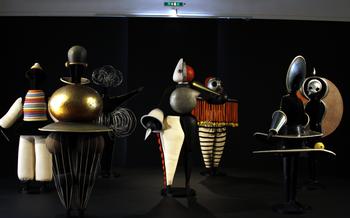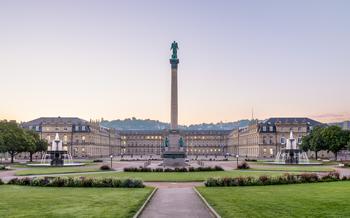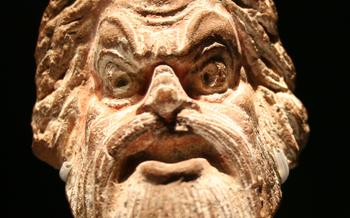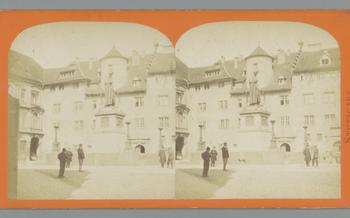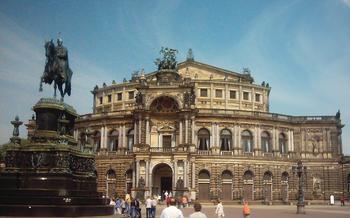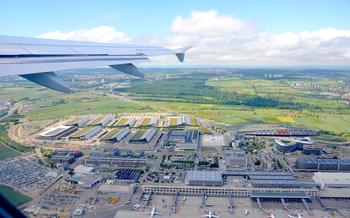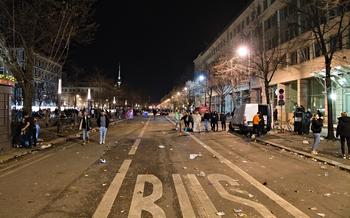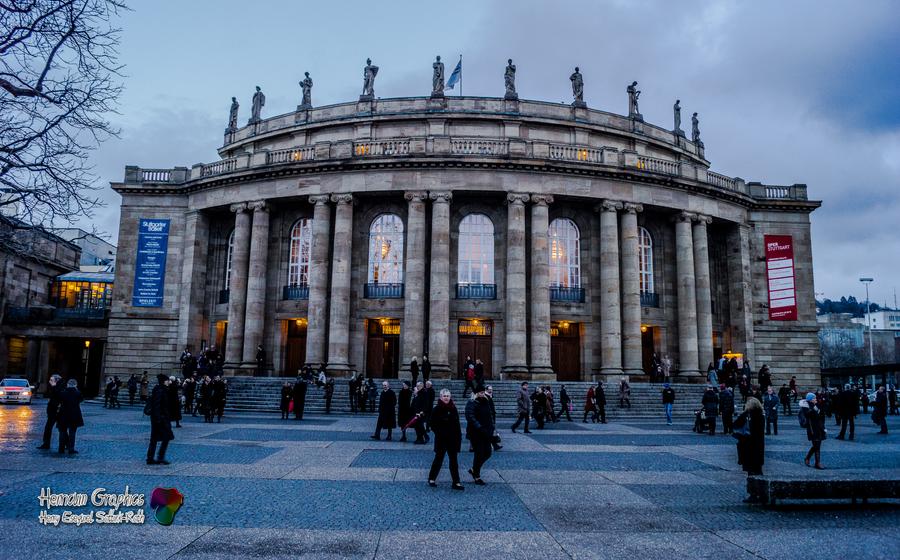
Stuttgart Opera House
- Stuttgart Opera House: A Cultural Landmark in the Heart of Germany
- Step into the Grand Foyer: A Showcase of Architectural Elegance
- Experience World-Class Performances: From Opera to Ballet
- Admire the Stunning Neoclassical Facade: A Masterpiece of Architecture
- Explore the Fascinating History of the Stuttgart Opera House
- Discover the Rich Cultural Heritage of Stuttgart Through the Opera
- Unveil the Secrets of the Stuttgart Opera House: Guided Tours
- Dress to Impress: The Etiquette of Attending the Opera
- Delve into the World of Opera Through Educational Programs
- Capture the Beauty of the Stuttgart Opera House in Your Photos
- Plan Your Visit to Stuttgart: Practical Tips for Travelers
- Insider Tip: Enhance Your Experience with a Post-Opera Stroll
Stuttgart Opera House: A Cultural Landmark in the Heart of Germany
In the vibrant city of Stuttgart, nestled amidst lush green hills and bustling streets, stands the Stuttgart Opera House, a majestic cultural landmark that has captivated hearts and minds for over a century. With its rich history, stunning architecture, and world-class performances, the Stuttgart Opera House is an unmissable destination for art enthusiasts, music lovers, and travelers seeking an unforgettable experience.
History
The Stuttgart Opera House traces its roots back to the late 19th century when the city's growing cultural scene demanded a grand venue dedicated to the performing arts. In 1902, the foundation stone was laid, and in 1912, the doors of the magnificent opera house finally opened to the public. Over the decades, the opera house has hosted countless memorable performances, witnessed historical events, and played a pivotal role in shaping Stuttgart's cultural identity.
Architecture
The Stuttgart Opera House is a masterpiece of neoclassical architecture, designed by renowned architect Max Littmann. Its imposing facade, adorned with intricate carvings and sculptures, reflects the grandeur and elegance of a bygone era. The interior of the opera house is equally impressive, boasting a grand foyer with soaring ceilings, opulent chandeliers, and sweeping staircases. Every detail, from the intricate murals to the plush red velvet seats, exudes a sense of timeless sophistication.
Performances
The Stuttgart Opera House is renowned for its diverse and high-caliber performances, encompassing opera, ballet, and concerts. The opera repertoire ranges from classic masterpieces like Verdi's "Aida" and Mozart's "The Magic Flute" to contemporary works by acclaimed composers. The Stuttgart Ballet, known for its technical brilliance and artistic innovation, presents a captivating array of ballets, from traditional favorites to cutting-edge contemporary pieces. The opera house also hosts a variety of concerts, featuring renowned orchestras, soloists, and conductors, offering a platform for both classical and contemporary music.
Significance
The Stuttgart Opera House holds a significant place in the cultural landscape of Germany. It is not only a premier venue for the performing arts but also a symbol of Stuttgart's rich cultural heritage and its commitment to artistic excellence. The opera house has played a crucial role in nurturing local talent, promoting cultural exchange, and inspiring generations of artists and performers. Its enduring legacy continues to attract visitors from around the world, reaffirming its status as one of Germany's most prestigious cultural landmarks.
Step into the Grand Foyer: A Showcase of Architectural Elegance
As you step through the grand entrance of the Stuttgart Opera House, you are greeted by the awe-inspiring foyer, a masterpiece of architectural elegance that sets the stage for an unforgettable evening. Designed with meticulous attention to detail, the foyer exudes a sense of grandeur and sophistication.
The walls are adorned with intricate murals depicting scenes from mythology and history, painted by renowned artists of the era. These murals transport visitors to another time and place, creating an enchanting atmosphere that enhances the overall experience of attending a performance.
The ceiling is adorned with opulent chandeliers, casting a warm glow that illuminates the opulent surroundings. These chandeliers, handcrafted by skilled artisans, are a testament to the artistry and craftsmanship that went into the creation of the opera house.
The grand staircase, with its sweeping curves and intricate balustrades, is a focal point of the foyer. It invites visitors to ascend to the upper levels of the opera house, where they can enjoy stunning views of the stage and the auditorium.
Experience World-Class Performances: From Opera to Ballet
At the Stuttgart Opera House, the stage comes alive with a diverse repertoire of world-class performances that cater to every taste. Opera, the cornerstone of the theater's offerings, transports audiences to realms of passion, drama, and soaring melodies. Renowned opera singers grace the stage, captivating hearts with their powerful voices and emotive performances. From the classics of Mozart and Verdi to contemporary masterpieces, the opera season promises an unforgettable musical journey.
Ballet, with its graceful movements and expressive storytelling, takes center stage at the Stuttgart Opera House. The resident Stuttgart Ballet, renowned for its technical prowess and artistic excellence, brings to life enchanting tales through the language of dance. From the ethereal beauty of Swan Lake to the dynamic energy of Spartacus, the ballet performances offer a visual feast that will leave you spellbound.
In addition to opera and ballet, the Stuttgart Opera House hosts a variety of concerts throughout the year. These concerts feature renowned orchestras, soloists, and ensembles, presenting a diverse range of musical genres from classical to contemporary. From the stirring symphonies of Beethoven to the intricate compositions of modern masters, the concert season offers a rich and varied musical experience.
The Stuttgart Opera House also hosts special events that push the boundaries of traditional performance. These events may include experimental theater productions, contemporary dance showcases, or multimedia performances that blend music, dance, and visual arts. These special events offer a unique and immersive experience that challenges perceptions and opens up new possibilities in the world of performing arts.
Admire the Stunning Neoclassical Facade: A Masterpiece of Architecture
The Stuttgart Opera House's neoclassical facade is a testament to the architectural brilliance of the 19th century. Its symmetrical design, grand columns, and intricate pediments create a majestic presence that commands attention. The facade is adorned with intricate carvings and sculptures depicting mythological figures and scenes from Greek and Roman mythology, adding a touch of grandeur to the building's exterior.
The imposing columns that line the facade add a sense of strength and stability to the structure. Their fluted surfaces and Corinthian capitals create a visually appealing contrast against the smooth stone walls. The pediment, which crowns the facade, features a sculpted relief depicting Apollo, the Greek god of music and poetry, surrounded by muses representing the different arts. This exquisite artwork serves as a fitting symbol for the cultural significance of the Stuttgart Opera House.
The overall design of the facade exudes a sense of harmony and balance, reflecting the classical principles of architecture that were prevalent during the 19th century. The careful attention to detail and the use of high-quality materials contribute to the building's timeless beauty and elegance.
Explore the Fascinating History of the Stuttgart Opera House
The Stuttgart Opera House boasts a rich and captivating history that has shaped its status as a cultural landmark. Its origins can be traced back to the early 19th century when the desire for a dedicated opera house in Stuttgart gained momentum. In 1805, the foundation stone was laid for the first opera house, which was inaugurated in 1810 and quickly became a hub for musical and theatrical performances.
The early years of the opera house witnessed a series of remarkable achievements, including the premiere of Franz Schubert's opera "Alfonso und Estrella" in 182However, tragedy struck in 1902 when a devastating fire engulfed the building, destroying much of its interior and leaving only the outer walls standing.
Undeterred by this setback, the city of Stuttgart embarked on an ambitious reconstruction project, resulting in the grand opera house that stands today. The new building, designed by renowned architect Max Littmann, was completed in 1912 and marked a significant milestone in the cultural history of Stuttgart.
The Stuttgart Opera House faced its most challenging period during World War II when it was heavily damaged by Allied bombings. The auditorium, stage, and much of the interior were reduced to rubble, leaving only the facade intact. The reconstruction process after the war was a testament to the resilience and dedication of the Stuttgart community, who worked tirelessly to restore their beloved opera house to its former glory.
In 1962, the Stuttgart Opera House reopened its doors, symbolizing a new chapter in its illustrious history. Since then, it has continued to thrive as a premier venue for opera, ballet, and concerts, attracting audiences from around the world. Today, the Stuttgart Opera House stands as a testament to the enduring power of art and the unwavering spirit of the Stuttgart community.
Discover the Rich Cultural Heritage of Stuttgart Through the Opera
The Stuttgart Opera House stands as a testament to the city's vibrant cultural heritage. It is deeply intertwined with local traditions and has played a pivotal role in shaping Stuttgart's cultural identity. The opera has been a platform for showcasing local talent and fostering a sense of community. It has also served as a bridge between the city's past and present, preserving and celebrating its rich artistic legacy.
The opera house has had a profound impact on the cultural landscape of Stuttgart. It has been instrumental in promoting the arts and attracting visitors from around the world. It has also played a crucial role in educating and inspiring young people, fostering a love for music and theater. The opera house has collaborated with local schools and organizations to offer educational programs, workshops, and masterclasses, introducing students to the world of opera and nurturing their artistic talents.
Beyond its artistic contributions, the Stuttgart Opera House has also played a significant role in fostering community involvement. It has provided a platform for local artists, musicians, and performers to showcase their talents and contribute to the cultural fabric of the city. It has also been a venue for community events, fundraisers, and galas, bringing people together and strengthening the bonds of the community.
The Stuttgart Opera House is truly a cultural treasure that embodies the rich heritage of the city. It is a place where history, art, and community converge, creating a vibrant and dynamic cultural landscape. Attending a performance at the opera house is not just an evening of entertainment; it is an opportunity to immerse oneself in the cultural tapestry of Stuttgart and experience the passion and creativity that define this vibrant city.
Unveil the Secrets of the Stuttgart Opera House: Guided Tours
Delve into the captivating world of the Stuttgart Opera House through its guided tours, offering an exclusive glimpse behind the scenes of this cultural landmark. Led by knowledgeable guides, these tours provide an immersive journey into the history, architecture, and performances that make the opera house so renowned.
Explore the grand foyer, adorned with intricate murals, opulent chandeliers, and a sweeping grand staircase. Discover the hidden stories behind the neoclassical facade, with its majestic columns, elaborate pediment, and exquisite sculptures.
Learn about the fascinating history of the opera house, from its origins in the 19th century to its destruction during World War II and subsequent reconstruction. Gain insights into the intricate workings of the theater, including the technical aspects of staging world-class opera and ballet productions.
The guided tours also provide an opportunity to witness rehearsals, visit the costume and prop workshops, and meet some of the talented artists who bring the magic of the opera to life. Whether you are a seasoned opera enthusiast or simply curious about the inner workings of this cultural institution, the guided tours offer a truly unforgettable experience.
Dress to Impress: The Etiquette of Attending the Opera
Attending the opera is a special occasion that calls for a certain level of formality in attire. The dress code at the Stuttgart Opera House is typically formal, with a preference for dark suits, tuxedos, or evening gowns. Women may also opt for elegant cocktail dresses or pantsuits. It is important to dress respectfully, as a sign of appreciation for the performers and the grandeur of the occasion.
Accessories should be kept to a minimum and should complement the overall outfit. Avoid wearing anything too flashy or distracting, as it may take away from the performance. For men, a simple tie or bow tie is appropriate, while women may choose to wear a scarf or shawl.
Etiquette at the opera is also important to consider. Arrive on time, as latecomers may be asked to wait until an appropriate moment to enter the auditorium. During the performance, avoid talking, using your phone, or making any noise that may disturb other patrons. Applaud politely at the end of each act and at the curtain call to show your appreciation for the performers.
By following these simple guidelines, you can ensure that you have a pleasant and enjoyable experience at the Stuttgart Opera House.
Delve into the World of Opera Through Educational Programs
The Stuttgart Opera House offers a diverse range of educational programs designed to deepen your understanding and appreciation of opera. Whether you are a seasoned opera enthusiast or a newcomer looking to explore this art form, these programs provide valuable insights into the world of opera.
Workshops: Engage in hands-on workshops that teach you the fundamentals of opera, from vocal techniques to stagecraft. These workshops are led by experienced professionals and offer a unique opportunity to learn from the experts.
Lectures: Attend thought-provoking lectures that delve into the history, theory, and criticism of opera. These lectures are given by renowned scholars and provide a deeper understanding of the cultural and historical significance of opera.
Exhibitions: Explore interactive exhibitions that showcase the history and behind-the-scenes workings of the Stuttgart Opera House. These exhibitions feature costumes, props, set designs, and other artifacts that bring the world of opera to life.
Masterclasses: Witness the magic of opera firsthand by attending masterclasses led by world-renowned opera singers and conductors. These masterclasses offer an intimate glimpse into the artistry and technique of these talented performers.
Capture the Beauty of the Stuttgart Opera House in Your Photos
The Stuttgart Opera House is a feast for the eyes, and capturing its beauty through photography is a wonderful way to preserve your memories of this architectural masterpiece. Whether you're a seasoned photographer or simply enjoy taking snapshots, here are some tips to help you take stunning photos of the opera house:
-
Choose the right angle. The best way to capture the grandeur of the opera house is to photograph it from a low angle, looking up at the facade. This will emphasize the height and majesty of the building.
-
Pay attention to the light. The best time to photograph the opera house is during the golden hour, just after sunrise or just before sunset. The warm light will enhance the colors of the building and create a beautiful glow.
-
Use a tripod. A tripod will help you keep your camera steady, which is essential for capturing sharp photos, especially in low-light conditions.
-
Compose your shot carefully. Take some time to look around and find the best composition for your photo. Experiment with different angles and perspectives until you find one that you like.
-
Don't be afraid to experiment. Photography is all about experimentation. Try different settings on your camera, use different lenses, and take photos from different angles. You may be surprised at the results you get.
With a little planning and effort, you can capture stunning photos of the Stuttgart Opera House that will remind you of your visit to this beautiful city for years to come.
Plan Your Visit to Stuttgart: Practical Tips for Travelers
To make the most of your visit to the Stuttgart Opera House, careful planning is essential. Here are some practical tips to ensure a smooth and enjoyable experience:
Accommodation: Stuttgart offers a wide range of accommodation options to suit every budget and preference. From luxurious hotels to cozy guesthouses, there's something for everyone. Consider booking your stay near the city center to be within easy reach of the opera house and other attractions.
Transportation: Stuttgart has an efficient public transportation system that makes it easy to get around the city. The U-Bahn (metro) and S-Bahn (commuter rail) are particularly convenient for reaching the opera house, which is located near the Staatsgalerie stop. Taxis are also readily available if you prefer a more direct route.
Dining Options: Stuttgart is a culinary paradise with a diverse range of restaurants to choose from. Whether you're craving traditional German cuisine or international flavors, you'll find plenty of options within walking distance of the opera house. Be sure to try some local specialties, such as Maultaschen (Swabian ravioli) or Spätzle (egg noodles).
Tourist Information: The Stuttgart Tourist Information Center is an invaluable resource for visitors to the city. Located in the heart of the city center, it provides maps, brochures, and advice on attractions, events, and transportation. The friendly staff can also help you book tickets for the opera and other performances.
Insider Tip: Enhance Your Experience with a Post-Opera Stroll
After a captivating performance at the Stuttgart Opera House, extend your evening with a leisurely stroll through the city's vibrant streets. Just a short walk away, you'll find yourself immersed in the charm of the Schlossgarten, one of Stuttgart's most beloved parks. Stroll along its winding paths, marvel at the blooming flowers, and admire the tranquil Rosenstein Palace.
For a culinary delight, head to one of the many restaurants and cafes that line the streets surrounding the opera house. Indulge in traditional German cuisine at a cozy tavern, or savor international flavors at a trendy bistro. As the evening unfolds, the city comes alive with a vibrant nightlife scene. Explore the bustling bars and clubs, or immerse yourself in the lively atmosphere of a traditional beer garden.
Take advantage of your post-opera stroll to discover Stuttgart's hidden gems. Visit the Old Town, with its charming half-timbered houses and quaint boutiques. Admire the grandeur of the Neues Schloss, the city's former royal palace, or explore the fascinating exhibits at the Mercedes-Benz Museum, a testament to Stuttgart's automotive heritage.
Whether you seek tranquility, culinary delights, or vibrant nightlife, a post-opera stroll in Stuttgart promises a memorable and enriching experience, allowing you to fully embrace the city's cultural and historical legacy.
